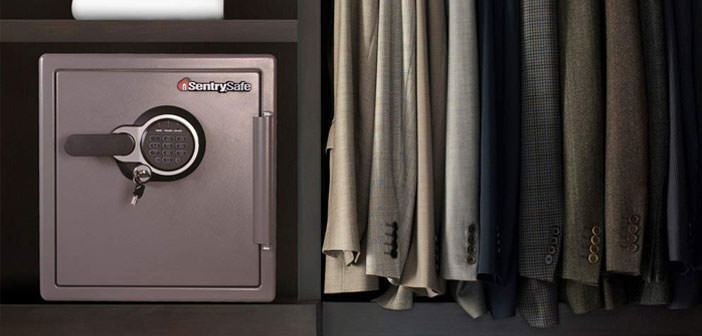If none of my top 7 home safe picks seem quite right for you, don’t worry! If you keep reading, I will guide you through 7 simple steps that guarantee you’ll find the perfect safe for both you and your home.
As I’ve already said, the best home safe provides much more than just security and protection for your valuables, it should also be easy for you to use, especially if you plan on using it daily.
Choosing the right one requires balancing the level of security and type of protection you need with the items you intend on keeping in your safe.
There are also other considerations including:
- how much your valuables are worth in terms of both market and sentimental value;
- where and how your safe will be installed in your home;
- whether the walls or floors are suitable for anchoring or mounting the safe;
- what you can afford to spend.
That's a lot to think about, right? Sure is! But if you follow each of the steps below, the process becomes very straightforward.
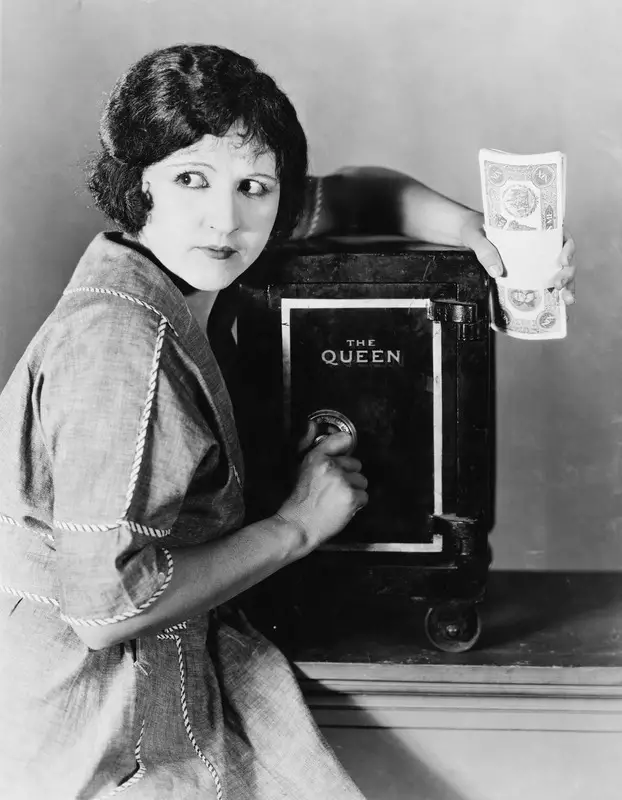
- Choose the right items to store
- Estimate the market value of your items
- Choose the right size or capacity
- Choose the right level of burglar protection
- Choose the right level of fire protection
- Choose the right type of locking mechanism
- Choose the right type of safe for your home
Step 1: Choose the right items to store
When buying residential safes, or commercial safes for that matter, the first thing to do is determine what type of assets, valuables or items are you going to keep in the safe.
Here's a list of the items home safes are typically used for within the home:
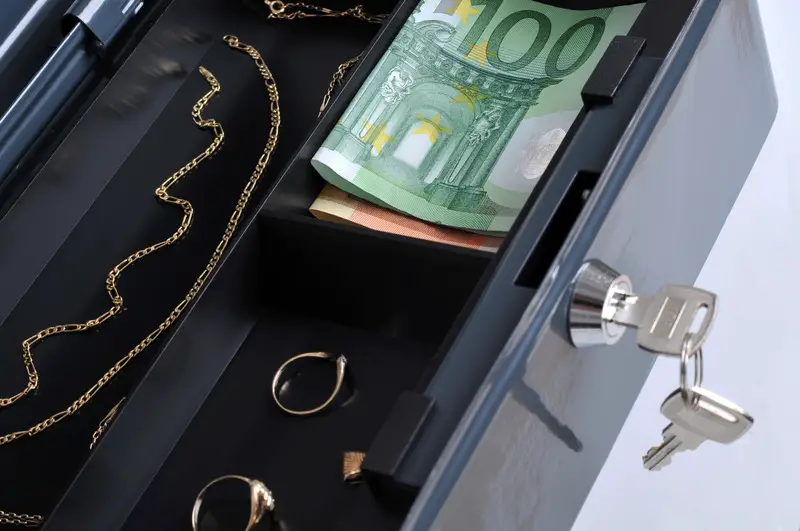
- Documents
- Collectibles
- Jewelry
- Digital media
- Electronics
- Cash
- Guns
Step 2: Estimate the market value the items to store
The insurance industry recommends spending at least 10% of the value of the items to be protected, that is $5000.00 =$500.00.
Expect to pay considerably more if you want both fire and adequate burglary protection in the same unit.
Irreplaceable items, keepsakes, and business/personal records are very difficult to place a value on; therefore, you may require professional assistance in choosing a safe to protect these items.
Step 3: Choose the right size or capacity
Now we know what we need our home safe for, and have estimated the value of the safe, we can begin to think about what are our size and capacity requirements.
While you certainly want to select a safe that can comfortably fit all your valuables into, you may want to consider opting for a slightly larger capacity in case you acquire other valuables.
It is cheaper to purchase the larger capacity safe that you are considering buying than it is to buy an extra safe for your home.
Step 4: Choose the right level of burglar protection
As I'm sure you know already, the ultimate objective of having a safe is so you can store and protect personal items that you consider to be of significant importance to you from unauthorized access, usually in the form of theft by a burglar.
While security, or protection against burglary, holds the most weight for most people buying a safe, not everyone needs the same level of burglar protection out of his or her safe.
For example, a person storing important documents and a few collectibles with an alarm system that they use, probably doesn't need the same burglar protection rating as a person securing the same kind of items inside their urban house that isn't fitted with an alarm or surveillance cameras.
How can I know what level of burglar protection I need?
There are many variables to consider when determining the appropriate level of security you may need.
By addressing the questions in the table below you should have a good idea whether or not the best home safe for you requires having a burglar protection rating...
Questions | Low Risk | High Risk |
|---|---|---|
Where do you live? | Small town or village | Big town, city or urban area |
Is the crime level high in your neighborhood? That is, are there a lot of break-ins? | No | Yes |
Has your home ever had a burglary take place? | No | Yes |
Do you have a home alarm system that both works and you use? | Yes | No |
If you had three or more answers in the “High Risk” column, then you'll require a home safe that will provide you with a greater level of protection against burglary.
On the other hand, if you had three or more answers in the “Lower Risk” column, then perhaps you could get away with a safe for your home that offers a lower degree of burglar protection.
How can I know how secure a home safe is from the threat of burglary?
O.K., so now that you have a fair idea what level of burglar protection and security the safe you're looking for should have, you're probably thinking how can you determine which home safes will provide that protection?
Firstly, it is important to note that no home safe is impenetrable.
If a burglar really wants to penetrate your safe, with the right skill, tools and time, he or she can, and will. Just like a home alarm system, a safe just buys you more time.
And the better the safe you have, the more time it buys you.
Safes are classified by either how long a safe can keep a burglar out or how long it can keep a fire from damaging the contents of the safe.
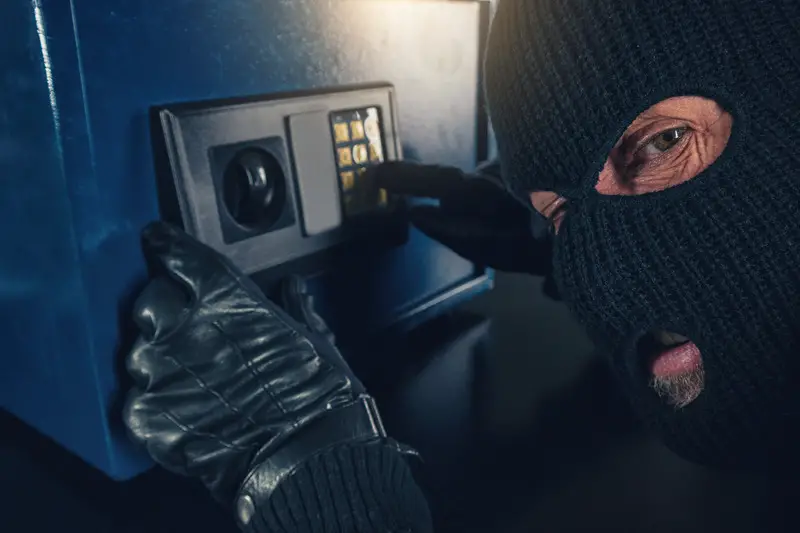
How well a safe goes up against the numerous tools thieves use to attack it, is determined by the construction quality alone (for safes on the lower end of the burglar protection rating spectrum) or by both construction quality and performance (for safes on the higher end of the burglar protection rating spectrum).
Construction quality is determined by the thickness and type of steel used in building the safe. Other things to look for include lock work, hard plates, and re-lockers.
More recently, we're seeing safes like this Sentry Safe Fire and Water Safe that have an alarm feature that sets a loud audible siren if someone tries to pick the safe up, move it, pry open or enter the safe's code incorrectly too many times.
Performance is measured in terms of the length of time it takes to open a safe door or make an opening using common hand tools, picking tools, mechanical or portable electric tools, grinding points, carbide drills and pressure applying devices or mechanisms, abrasive cutting wheels and power saws.
Home safes with thickness of less than 1/4-inch steel body and ½ inch steel door, could easily be opened in less than five minutes by most first-time thieves simply using standard hand and mechanical tools for prying, drilling, punching, chiseling, and tampering attacks.
Assuming a person is given authority to break into the safes, have skills in safe cracking, right tools and plenty of time, can often take from 5 minutes to 8 hours to break into a safe designed for home domestic and commercial use.
It all boils down to the skill of the person attempting to break into the safe, how much information they have about the safe's construction, amount of time they have before being forced to abandon their attack, and even degree "luck".
However, unfortunately it’s a bit more complicated than this. The type of steel, the size, weight, locking mechanism and overall construction quality and performance features will all affect how well a safe that's designed for domestic use is able to protect against the threat of burglary.
The two resources for real-life security and burglar protection testing by subject matter experts including locksmiths and professional safe crackers that you have at your disposal are:
1. Safe brands themselves
Safe manufacturers put a considerable amount of resources into R&D. They simply have to if they want to be competitive.
A lot of the money they put into R&D involves testing the quality of their safes’ construction and performance.
Here’s a list of the best safe manufacturer of both residential safes and commercial safes based on performance, security and R&D investment:
- AGRESTI
- AMSEC
- BROWN SAFE
- CHUBBSAFES
- FIRST SECURITY SAFE CO.
- GARDEX
- HOLLON
- MESA SAFES
- SENTRY SAFE
- STACK-ON
2. Independent security safe testing and ratings
Luckily, there are also independent, third party experts that use standardized methods to test and rate a wide range of different safes according to their security performance and fire resistance.
Underwriters Laboratory Inc. (U.L) is a leading independent product safety testing and certification organization that develops standards for many products, materials, components, assemblies, tools and equipment including safes.
U.L was established in 1894, and its headquarters are in Northbrook, Illinois.
While there are many other rating organizations for safes, the most widely used and trusted by the home safe manufacturing industry and insurance sector is U.L.
A safe that passes one of the many U.L tests, the safe is awarded a specific rating, and a corresponding label will be fixed on the safe itself to indicate that it has passed a particular U.L test.
When searching for the right safe for you and your home, it is highly recommended that you look for home safes that have been tested by U.L as most insurance companies will lower premiums based on their testing standards.
A U.L burglary resistant safe is designed to provide burglary protection against attacks using a combination of steel and composite materials.
U.L rated safes depending on what tools were used, and how long they take, to get into.
Chisels, wenches, screwdrivers, power saws, cutting torches, crowbars, abrasive cutting wheels, jackhammers, even specified amounts of nitroglycerine are just a few of the "tools" UL technicians use during a safe attack.
Here’s a summary of the U.L Anti-Burglary Safe Testing Classification for safes:
Residential Security Container rating (RSC) – tool resistant on all six sides for up to five minutes of attack.
- TL – Tool Resistant
- TR – Torch Resistant
- X6 – Indicates that there is protection on all six sides of the container
- 15, 30 or 60 – indicates the amount of time the container can withstand an attack
In other words, a TL-15 safe is tool resistant for 15 minutes, on the door only. A TR-TL-30x6 safe is torch and tool resistant, for 30 minutes, on all six sides.
So, the bottom line is:
If your risk level is: | Low Risk | High Risk |
|---|---|---|
Your home safe’s security rating should be: | Between | Between |
It’s worth noting that in order to receive a rating from U.L, a safe must be submitted by the manufacturer.
And since manufacturers don’t submit every safe, there are some that would be worthy of a U.L rating that aren’t currently rated.
This is where the in-house rating comes in handy. For example, if one Mesa safe has a TR-30 rating, you can be confident that almost all their safes are RSC.
Of course, this is no use if your insurance policy specifies safes that have a U.L rating.
But if you don’t take out insurance, it’s a useful way to find a secure home safe even if it doesn’t have an official rating.
Step 5: Choose the right level of fire protection
Just like selecting a home safe with the right level of burglary protection, selecting one with the right level of fire resistance is a subjective choice.
Not everyone needs the same level of fire protection from his or her safe.
How can I know what level of fire protection I need?
Again, there are many variables that you should consider when determining the right level of protection against fire that you may need.
Going through the questions in the table below will give you a good idea whether or not the best fireproof safe for you requires having a certified fire protection rating...
Questions | Low Risk | High Risk |
|---|---|---|
Where do you live? | Non-fire prone area | |
Will you be storing papers (e.g. wills or other important documentations), digital media, electronics or cash? | No | Yes |
Do you have functioning smoke alarms in all sections of your home? | Yes | Yes |
Do you have fire alarms located in all main areas and bedrooms of your home both work and you regularly check the batteries? | Yes | No |
If you had three or more answers in the “High Risk” column, then you'll require a home safe that will provide you with a greater level of protection against fire.
On the other hand, if you had three or more answers in the “Lower Risk” column, then you could certainly get away with a safe for your home that offers a lower degree of fire protection.
How can I know how secure a home safe is from the threat of fire?
Again, the best way to determine the level of fire protection a home safe offers is to look for safes that have been tested. U.L also tests the fire resistance of home safes, and provides fire-resistance rating classifications accordingly.
U.L Fireproof Safe Testing Classifications: U.L have the following five fire resistant classifications:
- 1/2 Hour - UL class E Safe: Safes are heated for half an hour to reach an exterior temperature of 1550°F/843°C. Paper will begin to burn at approximately 451°F/232°C, meaning that the safe being tested must maintain an interior temperature of less than 350°F/176°C during testing in order to earn its U.L rating.
- 1 Hour - UL class D Safe: Safes are heated for one hour to reach an exterior temperature of 1700°F/927°C. Just as with the half hour test, the safe must maintain an interior temperature of less than 350°F/176°C throughout the test.
- 1 Hour Plus - UL class C Safe: Safes are heated for over one hour to reach an exterior temperature of 1700°F/927°C. Just as with the half hour test, the safe must maintain an interior temperature of less than 350°F/176°C throughout the test.
- 2 Hour - UL class B Safe: The unit is heated for two hours to reach an exterior temperature of 1850°F/1010°C. The safe must maintain an interior temperature of less than 350°F/176°C throughout the test.
- 4 Hour - UL class A Safe: The unit is heated for four hours to reach an exterior temperature of 2000°F/1093°C. Just as with the half hour test, the safe must maintain an interior temperature of less than 350°F/176°C throughout the test.
So, the bottom line is:
If your risk level is: | Low Risk | High Risk |
|---|---|---|
Your home safe’s security rating should be: | Either | Between |
Step 6: Choose the right type of locking mechanism
Locking mechanism options for you home safe
In addition to thinking about what you want to store in your home safe, size requirements and level of burglary and fire protection, it’s important to consider how you want it to lock.
There are four common types of locking mechanisms for home safes, each with a different purpose.
Consider these four locks so you can decide which locking mechanism on a home safe is right for you.
1. Dial/Combination
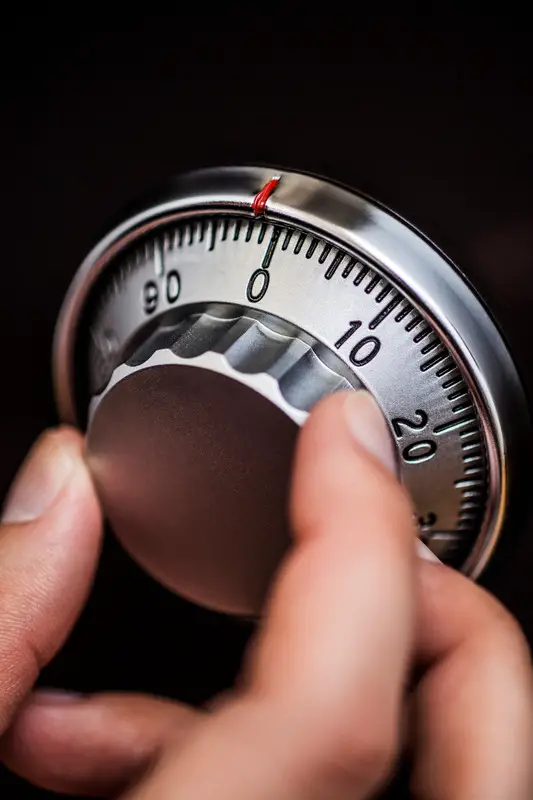
Advantages:
- Hard to crack given that there are one million possible combinations on a three-wheel combination lock
- Requires very little maintenance
- Very reliable.
Disadvantages:
- Takes considerable longer to get into than newer, more technologically advanced, locking mechanisms
- Requires you to remember the combination
Tip:
If possible, do not write your combination number down. If a burglar finds your combination it basically renders your safe useless.
2. Digital Number Keypad

Advantages:
- Usually quicker access than combination safes
- Programmable features
- Multiple programmable entry codes
- Automatic locking after failed entry attempts
Disadvantages:
- Normally more expensive than combination safes
- Need to change the batteries about once a year
- May be vulnerable to other electronic malfunctions
Tip:
Change the code often so that the numbers are not worn down by overuse and easily give away the combination to possible burglars.
3. Biometric Locks
Biometric locks use fingerprint or voice recognition, or retinal scans to open your home safe.
By implementing these types of personal identification, biometric locks are often considered the most secure form of a locking mechanism.
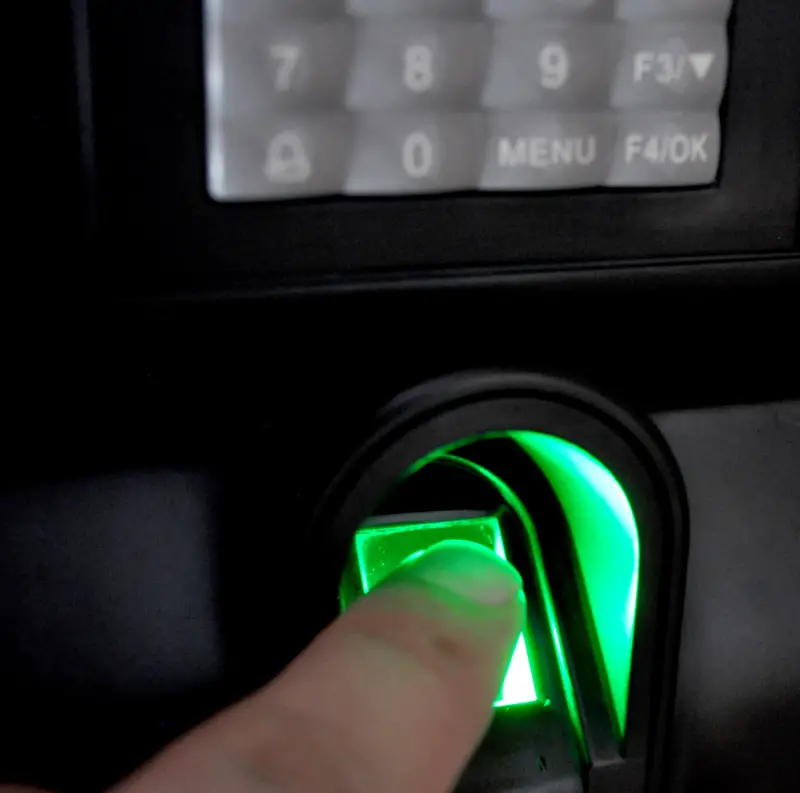
Advantages:
- Unlocking a safe is extremely quick (just as quick as unlocking your smartphone using the fingerprint recognition or retinal scan feature) – highly recommended if you use your safe to store guns.
- Can be programmed to read a multiple fingerprint, voices, or retinas so that other people can be given access where appropriate.
- Further increased security if a biometric safe is combined with a digital number keypad.
Disadvantages:
- Biometric safes and lock boxes are more expensive than safes that use other forms of locking mechanisms (though with advances in technology biometric safes are becoming less and less expensive).
- While rare, there are times the scanning does not work or fails to recognize a saved fingerprint.
4. Lock and Key
Advantages:
- You have a tangible object to keep which many people may find advantageous
Disadvantages:
- Usually less secure than other locking mechanisms given that your key can be stolen or misplaced
Tip:
If you do decide on a key lock safe, keep keys in a spot that is not obvious to thieves and consider keeping one key in a safe deposit box at a bank in case other keys are lost.
The bottom line is that your preferences will play a large part in deciding what type of locking mechanism to choose. Are you good at remembering passwords or combinations? Do you prefer quick access?
Consider this – which of the locking mechanisms discussed above do you think would be easiest for you to open when you need to retrieve items from your home safe?
Step 7: Choose the right type of home safe
Safes can be categorized into peril or style types. Falling under peril types are burglar safes and fire safes.
As the name suggests, burglar safes are built to protect valuables against burglary, and fire safes are used to protect items from damage caused by fire and heat.
Some manufacturers even offer combined, burglar and fire, options.
Falling under style (or design) types are traditional box-shaped safes that can either or not be anchored to the floor, hidden floor and wall safes, weapons (specifically gun and rifle) safes, security lock boxes and diversion safes.
Your choice will depend largely on the degree and type of protection necessary for the estimated value (both market and sentimental) of the items you are storing, the final placement of the safe, and price you are willing to spend.
You should also consider how easy the lock is to use and whether you need portability.
Fire safes
If you are looking for a safe for your home to protect important documents, such as a will, precious family photos etc., which would be of no real interest to a burglar, you should consider a simple fire safe.
While fire safes are not usually very secure, they are fire resistant, offering your valuable papers, documents, and photograph the best protection in the event of a house fire.
Security safes
Burglary/security safes offer significantly more security from break-in than fire safes.
Security safes are much heavier, as they are made of steel, which means they are hard to pick up and steel. Unless a burglar can get into the safe quickly, the chances of them being caught greatly increase.
These types of safes generally come with the mountable feature so that it can be bolted down to the floor or another surface.
You may want to move it from time to time, so keep that in mind when making your decision.
Most of these safes are fireproof, not just fire resistant. It’s always good practice to check the fire rating before buying.
Burglary/security safes come in an array of locking devices, including key lock, combination dial lock, electronic lock, biometric lock, dual lock and card swipe lock.
Many people use these types of safes to store and protect items such as cash, jewelry, or other precious items.
When considering a security safe for your home, you should look for thick doors and walls and make sure that the safe you buy has a high impact rating, which means that it won’t break apart even if dropped from a high location.
Wall Safes
The biggest advantage with wall safes is their concealment.
They tend to be smaller than home floor safes in terms of storage capacity and, depending on the model, can be easily wrenched and pried out of the attached wall, and carried in an over the shoulder fashion by just one person.
Wall safes excel for short-term storing of valuables or when you have items that should be kept away from children.
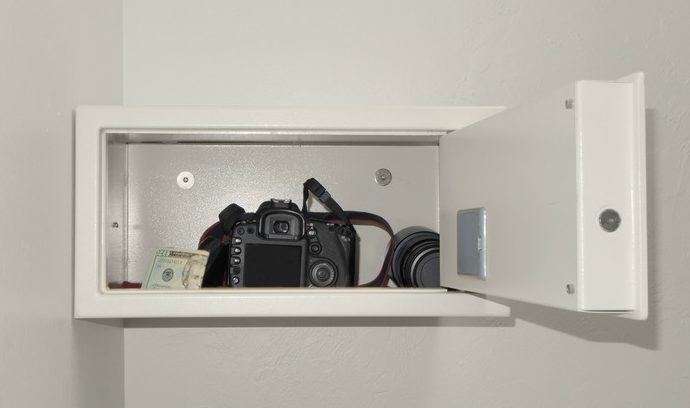
While at first, it may seem like an awesome idea – having a hidden wall safe just like in movies, most buyers of such safes typically express some degree of ‘buyer’s remorse’; often saying something to the effect of “I can hardly fit anything - should have just bought a normal safe”.
In almost all cases, the bottom line is that wall safes are designed for your average size home, lack adequate storage capacity to justify spending the money.
Unless you own a mansion, or already have a home floor cabinet safe and need an additional safe with greater concealment, then you can spend your money on much better safes.
It should be noted that if choosing to put a hidden wall safe in your house, it is highly recommended that first - you know exactly what you want to store in the safe before buying it.
That way you have a less chance of getting the wrong size for what you need it for; and second, you have a professional carpenter install a false wall in which the safe is mounted onto.
This will add to its concealment, and minimize damage to your home if attempts are made to rip it from the wall.
Floor safes
Floor safes are another type of hidden safe that can be embedded into a concrete floor. This makes them almost immune to removal and extremely difficult to locate for burglars
The disadvantage of fixing a floor safe to the ground is that if you move houses, or want to move the safe to another location generally, this becomes virtually impossible to do.
Drawer/nightstand safes
Drawer safes or sometimes referred to as a nightstand gun safe (because too often that’s what people want them for) are small enough to fit into a drawer.
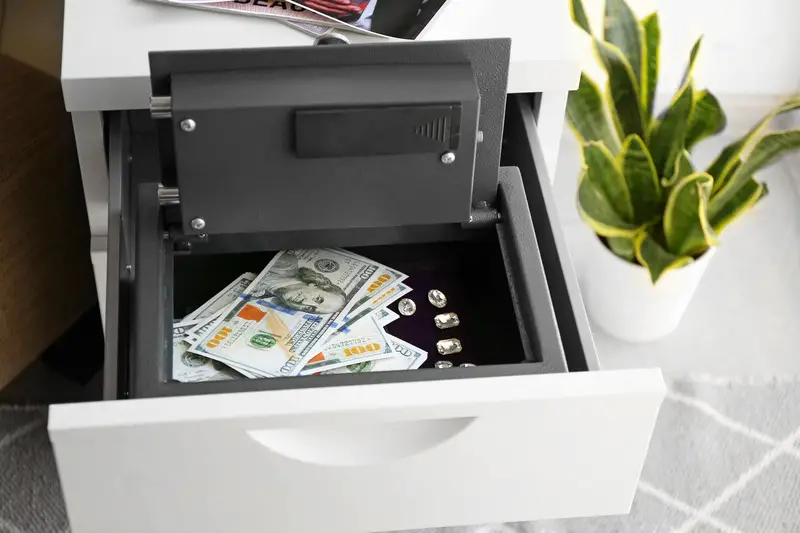
They usually open with a lock but with advances in technology, we are seeing more and more nightstand safes coming with biometric features.
While they don’t have a lot of room inside to store big items, they do a great job at keeping their contents (especially guns that you want to keep close to you but don’t want to risk your kids accidentally getting a hold of it) safer than if they were kept loose in a drawer.
Gun Safes and Cabinets
A gun safe is a storage device that is used to store guns in a secure way.
Quite a few varieties of this storage case are readily available in the market.
Starting from electronic gun safe to the traditional wheel and pin combination lock gun safes the market is brimming with variants that you can choose.
The listing below will help you understand about the different types of it in short:
Biometric Gun Safes
These can lock and open based on fingerprints identification.
These are designed in a high tech manner, which is why they cost more than the ordinary ones, and are equipped with anti-drilling steel plating that can prevent unauthorized access.
The only problem with low quality biometric gun safes is that they have a high rejection rate and can at times refuse access to the user as well.
Electronic Gun Safes
Is a secure way of keeping your gun actually safe in an enclosure that runs on battery or electricity?
An electronic keypad keeps it extra safe with 4, 5 or even 6 coded numbers which make it difficult to pry on.
However if you share the code with unknown people they can get easy access to it.
Vehicle Gun Safes
A gun has to be stored safely in a vehicle as much as the house.
This is why vehicle gun safes have come into the picture that are durable, unbreakable and have a locked casing.
Wheel and Pin Combination Safes
Remember the wheel and pin combination safes in Western movies? Yes, this conventional gun safe can be operated with a combination of usually three numbers.
These are fire and flood resistant, and why they are still popular. The problem with these safes is that the number dial may skip numbers many a time.
Key Lock Gun Safes
These are used for additional security purposes with a combination of locking systems like a digital keypad or key with a biometric one.
It may look difficult to some but once you get the hang of it, things will certainly turn out to be different.
Multiple Lock Gun Safes
These have a simple-to-use lock and key that can operate unperturbed.
Better quality ones can resist natural calamities like flood and fire.
The problem arises when you misplace the key but a call to a locksmith can take care of that within minutes.
Portable safes

If you require portability, especially if you’re traveling, then portable safes are a good investment.
Portable safes are a lot smaller than other types of safes, ensuring they can be easily moved around.
Portable safes are also great for jewellery, old coins, cash, or medication.
The Best Home Safe: a Summary
Given that this guide is quite long, a summary might be helpful. Follow this simple five step process to find the best home safe for you and your home:
Step #1: Choose the right items to store
Choosing what you want a home safe for before considering anything else informs you on what your sizing requirements are, and allows you to estimate the market value of the content.
This will provide guidance on the price ranges you should be looking at, as well as for insurances purposes.
Step #2: Estimate the market value of your items
Determine the value of all the items you plan on storing in the safe.
Step #3: Choose the right size or capacity
Lay everything you are going to store in your home safe out in your bed or in a box. Then choose a safe that will fit all your valuables.
Seriously consider getting a safe for your home that has a larger capacity than what you require at the time of purchasing in case you acquire other valuables that you want to store in the future. This will save you having to purchase another safe.
Step #4: Choose the right level of burglar protection
The best way to assess the level of security of a safe is to look for a U.L rating.
How do you know which rating you need? Just answer the questions in the table below.
Questions | Low Risk | High Risk |
|---|---|---|
Where do you live? | Small town or village | Big town, city or urban area |
Is the crime level high in your neighborhood? That is, are there a lot of break-ins? | No | Yes |
Has your home ever had a burglary take place? | No | Yes |
Do you have a home alarm system that both works and you use? | Yes | No |
Your home safe’s security rating should be: | Between | Between |
Step #5: Choose the right level of fire protection
Just like judging the level of security, the best way to assess the level of fire protection is to look for a U.L rating.
How do you know which rating you need? Just answer the questions in the table below.
Questions | Low Risk | High Risk |
|---|---|---|
Where do you live? | Non-fire prone area | |
Will you be storing papers (e.g. wills or other important documentations), digital media, electronics or cash? | No | Yes |
Do you have functioning smoke alarms in all sections of your home? | Yes | Yes |
Do you have fire alarms located in all main areas and bedrooms of your home both work and you regularly check the batteries? | Yes | No |
Your home safe’s fire rating should be: | Either | Between |
Step #6: Choose the right type of locking mechanism
There are four common types of locking mechanisms for home safes, each with a different purpose. They include: dial/combination, digital number keypad, biometric locks and lock and key.
What locking mechanism you choose is entirely up to you and what you prefer. Consider the advantages and disadvantages of all four above to make a more informed choice.
Step #7: Choose the right type of safe for your home
There are countless types of home safes available these days. What you require really depends on your needs.
Consider the extensive list of the different types of safes provided above and determine which will suit your requirements best.
Additional questions to consider when buying a safe for your home
How much money should I spend?
The insurance industry recommends spending at least 10% of the value of the items to be protected.
For example, if you have $5000.00 content value, that would equal a safe valued at approximately $500.00.
Which are the best safe manufacturers?
There are so many safe manufacturers to choose from these days. And a lot of the safes are of both poor build quality and low security.
To keep it simple, I like to stick to the big three: Amsec, Mesa Safes and Hollon Safes. And I honestly think that between them, they can provide something for everyone.
If you want the very highest quality, then go for an Amsec safe. Just be aware that you’ll pay a little bit more.
If you’re on a tight budget, then Sentry safes are usually the most competitively priced.
How far away is the nearest response to an alarm signal?
For example, if you live in a remote area where the fire department response time takes more than 30 minutes, you probably need to go with a higher rather than lower fire rating.
Making the final decision
Choosing a safe that can secure digital files, important paper documents, keys and other valuable items can be a struggle, especially if you need to get a good value for your money at the same time.
While you may be tempted to pick any safe for your home, you'll find that the best safes for home use aren't necessarily the most expensive one.
Every house safe provides unique features.
Do not choose one just for the sake of getting one because you have a few valuables you would like to store and protect.
Take a close look at the different features and options of each different type of safe and determine whether or not they fit your personal needs.
At the end of the day, if a safe keeps its items safe and secure then that’s all that matters. However, you may require specific features, which is when due diligence is necessary.
Just remember to always also ask yourself the questions set out in my guide to buying the best home safe, and ensure that it meets your needs.
Check out all top rated safes available on Amazon.
Also be sure to check out my other reviews:

